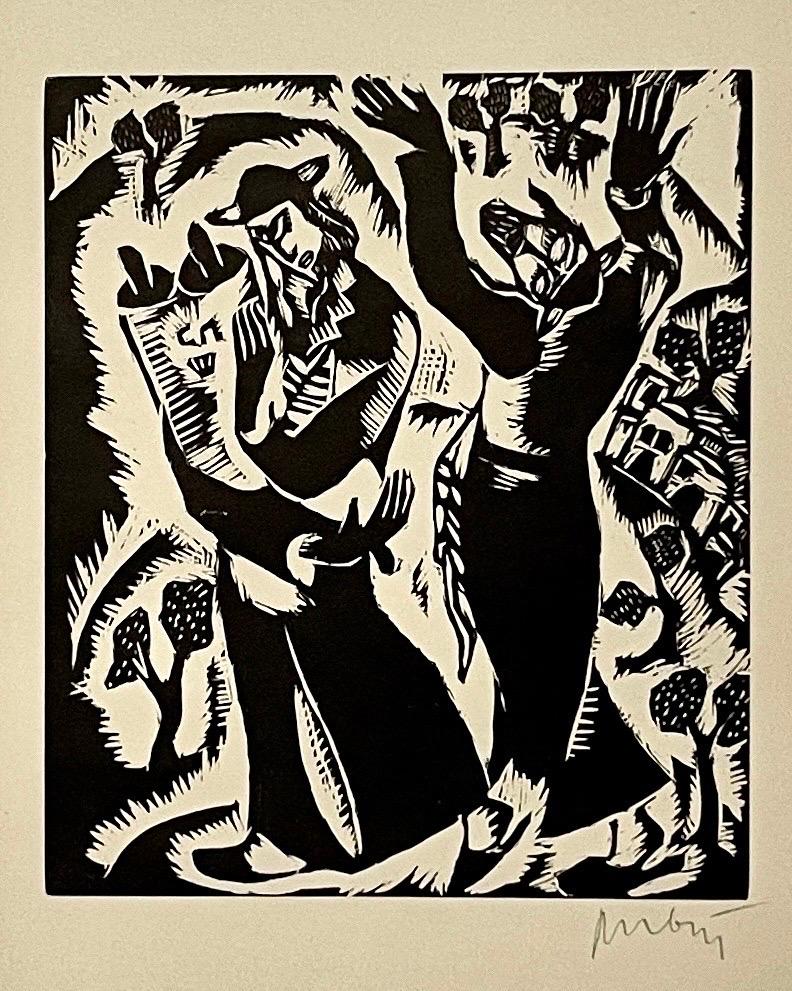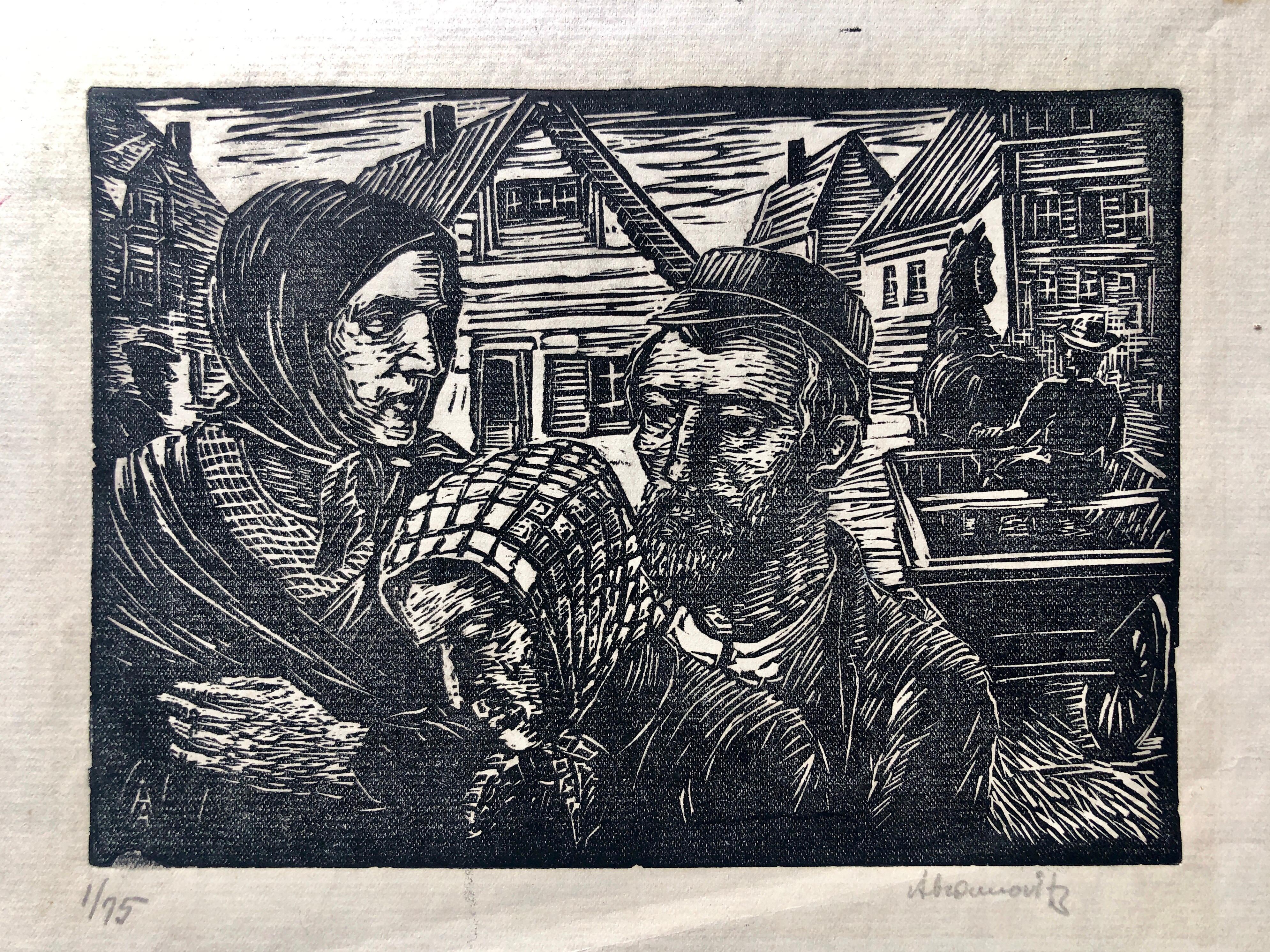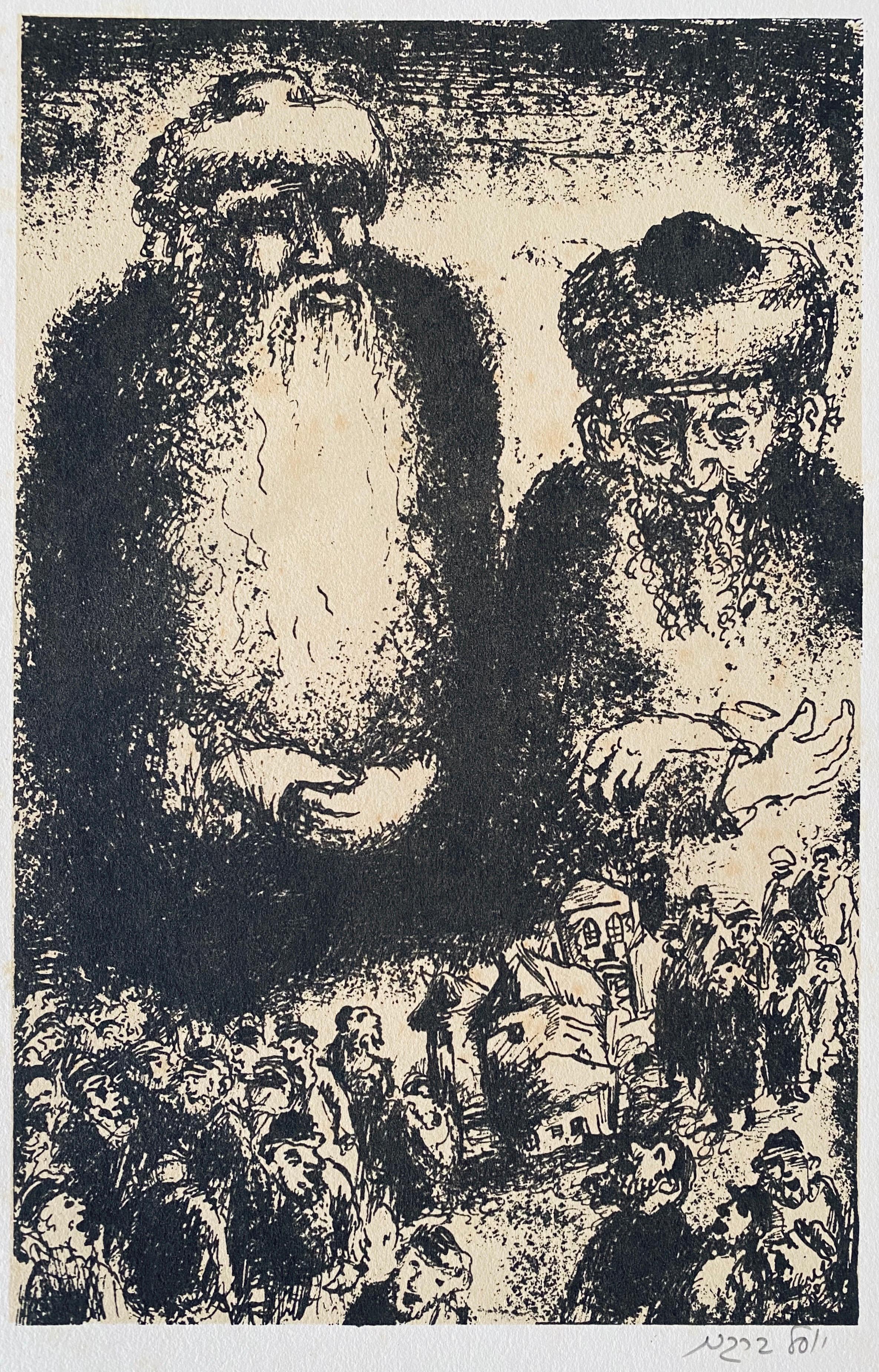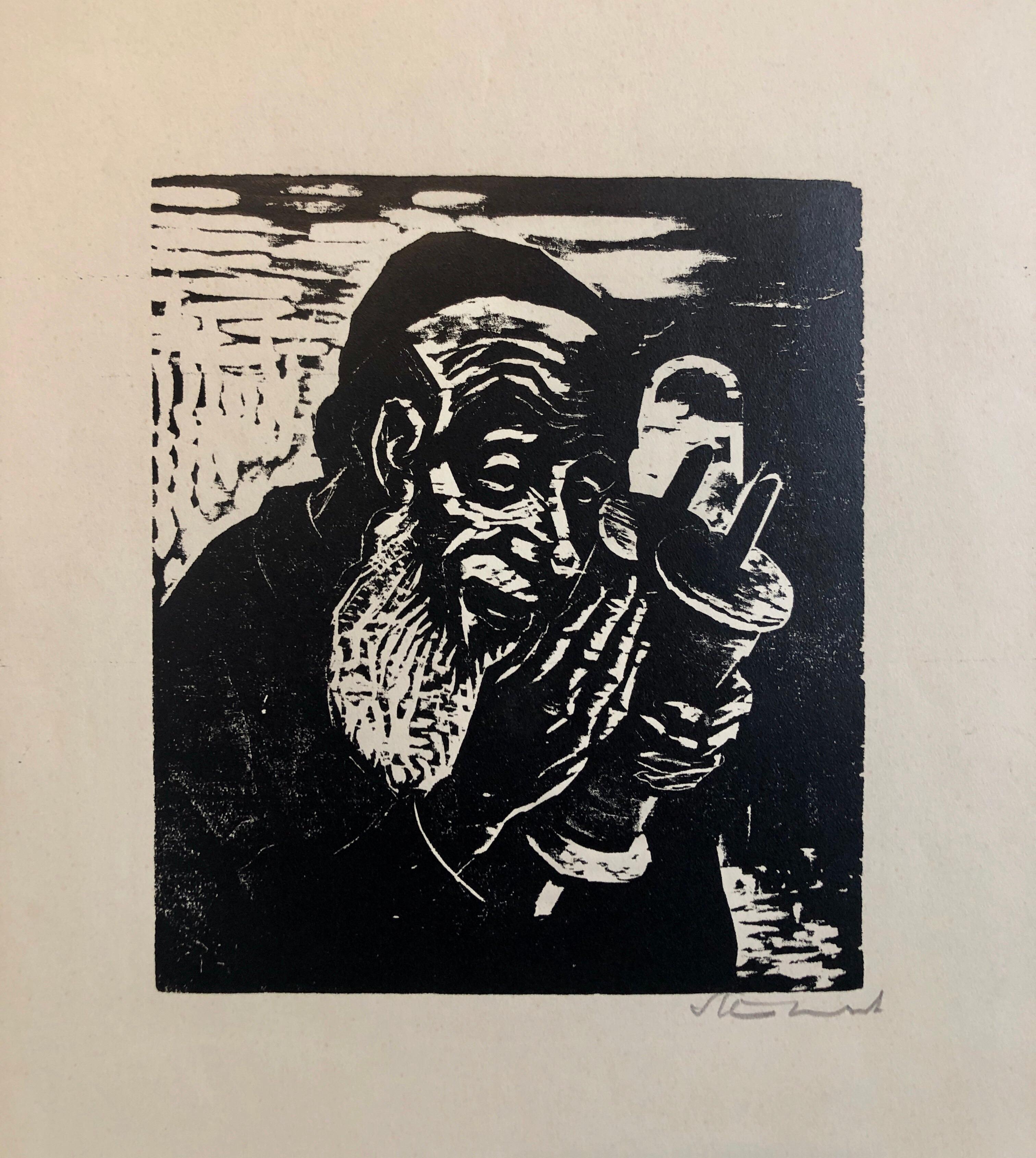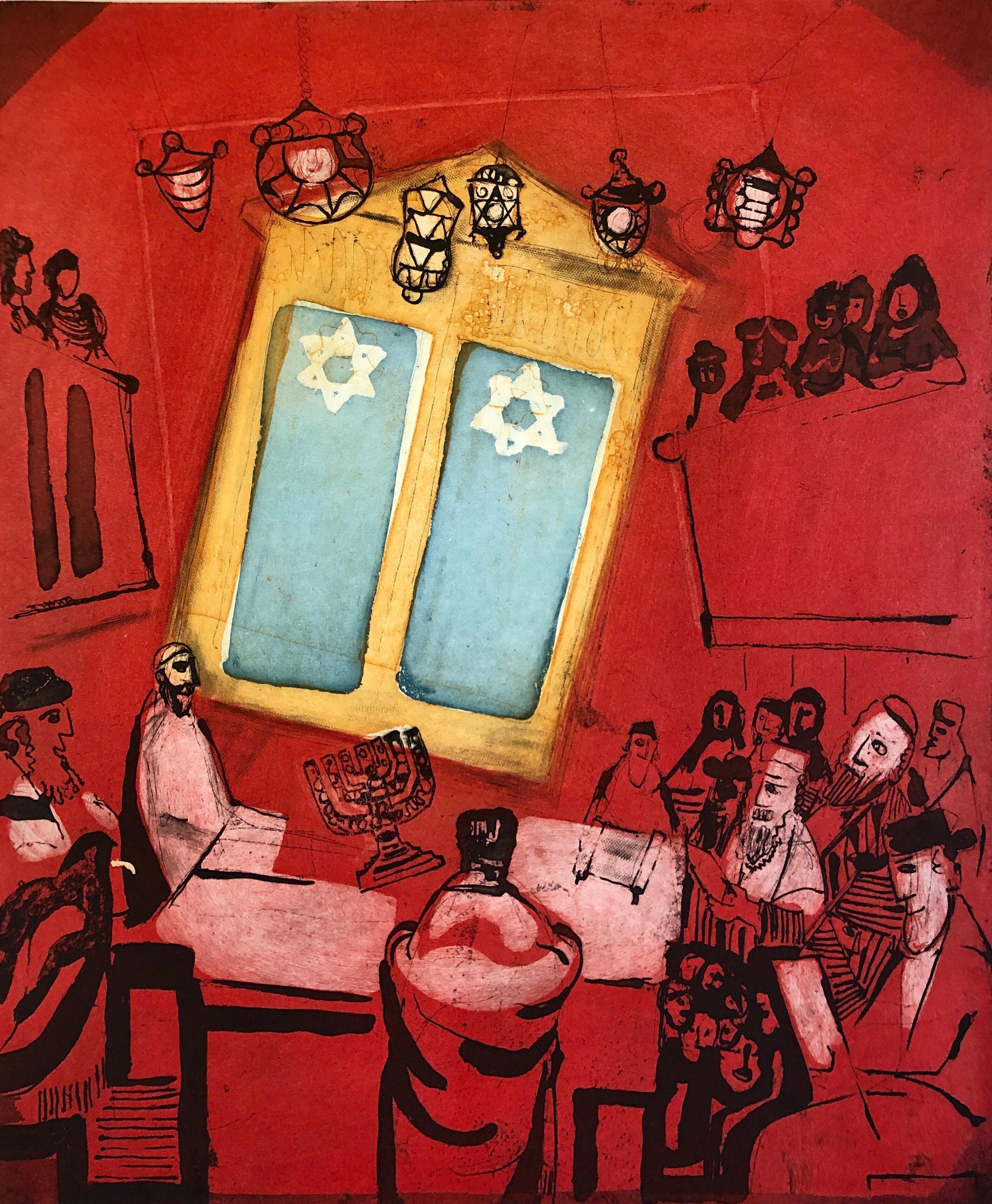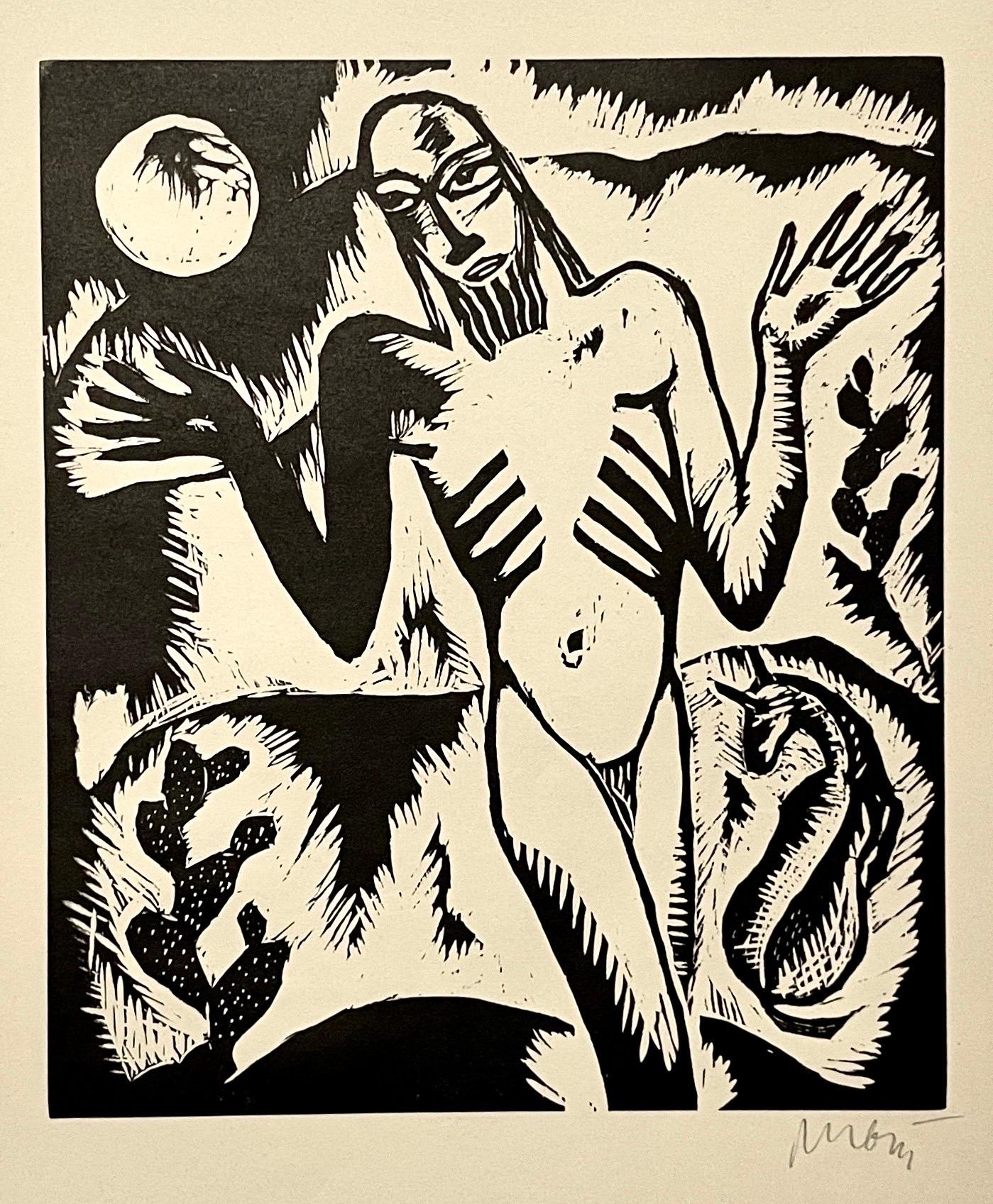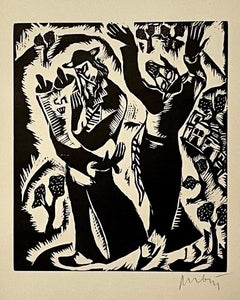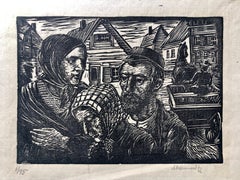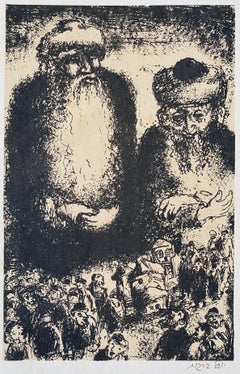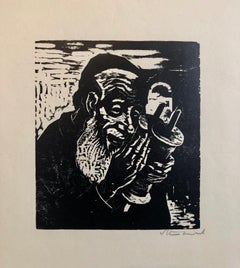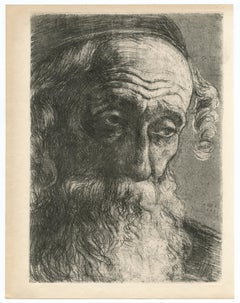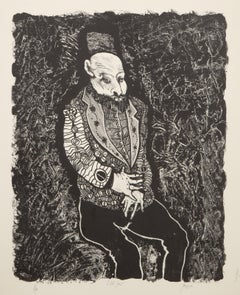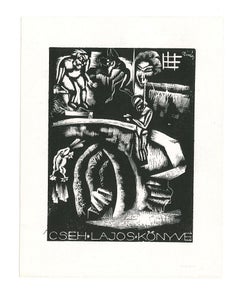Items Similar to 3 Jewish Men Judaica Woodblock Woodcut Engraving Print Chicago 1930s WPA Artist
Want more images or videos?
Request additional images or videos from the seller
1 of 6
Todros Geller3 Jewish Men Judaica Woodblock Woodcut Engraving Print Chicago 1930s WPA ArtistCirca Early to Mid 1900's
Circa Early to Mid 1900's
$550
£415.42
€480.10
CA$771.46
A$858.06
CHF 449.09
MX$10,465.51
NOK 5,642.99
SEK 5,307.96
DKK 3,583.50
About the Item
Todros Geller (1889 – 1949) was a Jewish American artist and teacher best known as a master printmaker and a leading artist among Chicago’s art community.Geller was born in Vinnytsia, the Russian Empire (now Ukraine) in 1889.[2] He studied art in Odessa and continued his studies after moving to Montreal in 1906 where he immigrated to Canada. He married and moved to Chicago in 1918, where he studied at the School of the Art Institute of Chicago until 1923.
Geller produced paintings, woodcuts, woodcarvings, and etchings. His work focused on Jewish tradition, often including moralistic themes and social commentary, shtetl, ghetto life, and the intersection of Jewish tradition with modern-day Chicago. He regarded art as a tool for social reform and he spent a large part of his career teaching art. His work was commissioned for stained glass windows, bookplates, community centers and Yiddish and English books. He was regarded as a leader in the field of synagogue and religious art. He designed stained glass window for synagogues in Omaha, Fort Worth, Dayton, Stamford, and Chicago Heights. Over the course of his career he illustrated more than 40 books.
In addition to conducting classes in his studio, Geller was head of art at the Jewish People’s Institute (JPI), supervisor of art for the Board of Jewish Education and director of art for the College of Jewish Studies (which became the Spertus Institute for Jewish Learning and Leadership) and taught at Hull House. Many prominent Chicago artists studied drawing and painting under Geller. Geller was a source of inspiration to Aaron Bohrod and Mitchell Siporin, among others. Irene Gordon was also among his pupils.
In 1926, Geller formed what would become a lengthy working relationship with Chicago publisher and cultural activist L. M. Shteyn (a pseudonym for Yitshak Leyb Fradkin, anglicized as L.M. Stein in his English language correspondence). Shteyn and Geller shared a similar ideology, were both considered radical progressives, were part of the Chicago Jewish Left who worked to promote the Yiddish language and they both supported the Soviet Union for its commitment to the Yiddish language and to the Jewish settlement in Birobidzhan. Shteyn's Yiddish press, the L. M. Shteyn Farlag, published at least eight monographs illustrated by Geller and four art albums dedicated to his work.
Geller was one of the founding members of "Around the Palette" in Chicago in 1926, a club where artists shared their personal views of art and its role in society. The club became the "American Jewish Art Club", in 1940 and subsequently the "American Jewish Artists Club" in the early 1990s. Other founding members included Emil Armin, David Bekker, Aaron Bohrod, Fritzi Brod, Samuel Greenburg, William S. Schwartz, Maurice Yochim and Louise Dunn Yochim.
In 1929, Geller visited Palestine, where he was inspired to paint Biblical themes such as his painting Jerusalem the Old which was included in the catalogue of the Art Institute of Chicago's thirty-third annual exhibition. He also created a woodcut series entitled Seven Palestinian motifs cut on wood in 1930.
He was the most prominent of the 14 graphic artists who participated in A Gift to Birobidzhan in 1937, an album of 14 woodcuts produced as a fund-raising project for the Chicago ICOR (whose acronym comes from the Yiddish name for the Association for Jewish Colonization in the Soviet Union) to support the Jewish Autonomous Oblast. Geller's contribution to the portfolio was a woodcut based on Raisins and Almonds, the Yiddish lullaby written by Abraham Goldfaden in 1880 for his operetta Shulamis. The other artists who contributed woodcuts were Alex Topchevsky, William Jacobs, Aaron Bohrod, David Bekker, Louis Weiner, Mitchell Siporin, Edward Millman, Fritzi Brod, Bernece Berkman, Morris Topchevsky, Abraham Weiner, Raymond Katz, and Ceil Rosenberg.
In 1937, Shteyn published a volume of about sixty woodcuts by Geller called From Land to Land, produced as part of the Federal Art Project (FAP), the visual arts arm of the Great Depression-era New Deal Works Progress Administration (WPA) Federal One program in the United States. The cover featured a goat on the shore of Lake Michigan with Chicago’s skyline in the background. As an important staple of Jewish life in Eastern Europe that were believed to have mystical qualities, goats were a dominant symbol in Geller’s artistic vocabulary. The woodcuts, four of which were in color, illustrated Jewish life, in addition to Native American, Spanish, Mexican, and Midwestern American themes.
Geller painted The Accordion Player in 1938 as part of the WPA Federal Art Project, an oil painting in the collection of the MacNider Art Museum in Mason City, Iowa. The WPA supported South Side Community Art Center opened in 1940 providing free art lessons for the community. Geller was a member of the interracial faculty of art instructors that included local black artists such as Charles Davis, Charles White, Bernard Goss, William Carter and local white artists such as Morris Topchevsky, Si Gordon and Max Kahn.
Geller became the first president of the American Jewish Arts Club following its formation in Chicago in 1940.
Hassidic (1927)
In 1942, Geller provided woodcut-illustrations for Jewish dancing master Nathan Vizonsky's book Ten Jewish Folk Dances: A Manual for Teachers and Leaders published by the American-Hebrew Theatrical League in Chicago.
Awards
Geller's woodcuts won three Library of Congress National Print Exhibition awards.[2][4]
The Spertus Institute for Jewish Learning and Leadership in Chicago has a collection of papers documenting Geller's career. The archive includes photographs, sketchbooks, original artwork, commissions for stained glass windows, various manuscript material including typescripts of articles, papers relating to the American Artists' Congress, 1937–1938, and correspondence with art organizations and artists such as Alexander Raymond Katz, Beatrice Levy, Archibald Motley, Increase Robinson, and Carl Zigrosser The papers cover his efforts to establish a Jewish museum in Chicago in 1928, involvement with the WPA Federal Art Project, participation in Artists Equity and the American Federation of Arts, his work teaching art to the Jewish community and his efforts to improve the working conditions and visibility of Jewish artists.
- Creator:Todros Geller (1889 - 1949, Ukrainian)
- Creation Year:Circa Early to Mid 1900's
- Dimensions:Height: 17 in (43.18 cm)Width: 13 in (33.02 cm)
- Medium:
- Movement & Style:
- Period:
- Condition:Minor wear commensurate with age. Measurements include frame.
- Gallery Location:Surfside, FL
- Reference Number:Seller: 18681stDibs: LU38212056922
About the Seller
4.9
Platinum Seller
Premium sellers with a 4.7+ rating and 24-hour response times
Established in 1995
1stDibs seller since 2014
1,799 sales on 1stDibs
Typical response time: <1 hour
- ShippingRetrieving quote...Shipping from: Surfside, FL
- Return Policy
Authenticity Guarantee
In the unlikely event there’s an issue with an item’s authenticity, contact us within 1 year for a full refund. DetailsMoney-Back Guarantee
If your item is not as described, is damaged in transit, or does not arrive, contact us within 7 days for a full refund. Details24-Hour Cancellation
You have a 24-hour grace period in which to reconsider your purchase, with no questions asked.Vetted Professional Sellers
Our world-class sellers must adhere to strict standards for service and quality, maintaining the integrity of our listings.Price-Match Guarantee
If you find that a seller listed the same item for a lower price elsewhere, we’ll match it.Trusted Global Delivery
Our best-in-class carrier network provides specialized shipping options worldwide, including custom delivery.More From This Seller
View AllRare 1923 Cubist Reuven Rubin Woodcut Woodblock Print Israeli Hasidic Judaica
By Reuven Rubin
Located in Surfside, FL
This is from the original first edition 1923 printing. there was a much later edition done after these originals.
These are individually hand signed in pencil by artist as issued.
This listing is for the one print. the other documentation is included here for provenance and is not included in this listing.
The various images inspired by the Jewish Mysticism and rabbis and mystics of jerusalem and Kabbalah is holy, dramatic and optimistic Rubin succeeded to evoke the spirit of life in Israel in those early days.
They are done in a modern art style influenced by German Expressionism, particularly, Ernst Barlach, Ernst Ludwig Kirchner, and Franz Marc, as introduced to Israel by Jakob Steinhardt, Hermann Struck and Joseph Budko.
Reuven Rubin 1893 -1974 was a Romanian-born Israeli painter and Israel's first ambassador to Romania.
Rubin Zelicovich (later Reuven Rubin) was born in Galati to a poor Romanian Jewish Hasidic family. He was the eighth of 13 children. In 1912, he left for Ottoman-ruled Palestine to study art at Bezalel Academy of Art and Design in Jerusalem. Finding himself at odds with the artistic views of the Academy's teachers, he left for Paris, France, in 1913 to pursue his studies at the École Nationale Supérieure des Beaux-Arts. He was of the well known Jewish artists in Paris along with Marc Chagall and Chaim Soutine,
At the outbreak of World War I, he was returned to Romania, where he spent the war years.
In 1921, he traveled to the United States with his friend and fellow artist, Arthur Kolnik. In New York City, the two met artist Alfred Stieglitz, who was instrumental in organizing their first American show at the Anderson Gallery. Following the exhibition, in 1922, they both returned to Europe. In 1923, Rubin emigrated to Mandate Palestine.
Rubin met his wife, Esther, in 1928, aboard a passenger ship to Palestine on his return from a show in New York. She was a Bronx girl who had won a trip to Palestine in a Young Judaea competition. He died in 1974.
Part of the early generation of artists in Israel, Joseph Zaritsky, Arieh Lubin, Reuven Rubin, Sionah Tagger, Pinchas Litvinovsky, Mordecai Ardon, Yitzhak Katz, and Baruch Agadati; These painters depicted the country’s landscapes in the 1920s rebelled against the Bezalel school of Boris Schatz. They sought current styles in Europe that would help portray their own country’s landscape, in keeping with the spirit of the time. Rubin’s Cezannesque landscapes from the 1920s were defined by both a modern and a naive style, portraying the landscape and inhabitants of Israel in a sensitive fashion. His landscape paintings in particular paid special detail to a spiritual, translucent light. His early work bore the influences of Futurism, Vorticism, Cubism and Surrealism.
In Palestine, he became one of the founders of the new Eretz-Yisrael style. Recurring themes in his work were the bible, the prophet, the biblical landscape, folklore and folk art, people, including Yemenite, Hasidic Jews and Arabs. Many of his paintings are sun-bathed depictions of Jerusalem and the Galilee. Rubin might have been influenced by the work of Henri Rousseau whose naice style combined with Eastern nuances, as well as with the neo-Byzantine art to which Rubin had been exposed in his native Romania. In accordance with his integrative style, he signed his works with his first name in Hebrew and his surname in Roman letters.
In 1924, he was the first artist to hold a solo exhibition at the Tower of David, in Jerusalem (later exhibited in Tel Aviv at Gymnasia Herzliya). That year he was elected chairman of the Association of Painters and Sculptors of Palestine. From the 1930s onwards, Rubin designed backdrops for Habima Theater, the Ohel Theater and other theaters.
His biography, published in 1969, is titled My Life - My Art. He died in Tel Aviv in October 1974, after having bequeathed his home on 14 Bialik Street and a core collection of his paintings to the city of Tel Aviv. The Rubin Museum opened in 1983. The director and curator of the museum is his daughter-in-law, Carmela Rubin. Rubin's paintings are now increasingly sought after. At a Sotheby's auction in New York in 2007, his work accounted for six of the ten top lots. Along with Yaacov Agam and Menashe Kadishman he is among Israel's best known artists internationally. Education
1912 Bezalel Academy of Arts and Design, Jerusalem
1913-14 École des Beaux Arts, Paris and Académie Colarossi, Paris
Select Group Exhibitions
Eged - Palestine Painters Group Eged - Palestine Painters Group, Allenby Street, Tel Aviv 1929
Artists: Chana Orloff, Abraham Melnikoff, Rubin, Reuven Nahum Gutman, Sionah Tagger,Arieh Allweil,
Jewish Artists Association, Levant Fair, Tel Aviv, 1929
Artists: Ludwig Blum,Eliyahu Sigad, Shmuel Ovadyahu, Itzhak Frenel Frenkel,Ozer Shabat, Menahem Shemi...
Category
1920s Abstract Figurative Prints
Materials
Woodcut
Jewish Shtetl Couple Judaica Woodblock c.1930s WPA Woodcut Print Hand Signed
By Albert Abramovitz
Located in Surfside, FL
Some of his prints were published by the WPA. it is a wood engraving signed in pencil. From a small edition.
Albert Abramovitz (1879-1963), born in Riga, Latvia, on January 24, 187...
Category
1930s American Impressionist Figurative Prints
Materials
Woodcut
Israeli Expressionist Yosl Bergner Modernist Lithograph
By Yosl Bergner
Located in Surfside, FL
Hand signed in Hebrew Lower right. Dimensions: H 19.5" x 13.5"
Bergner, Yosl (Vladimir Jossif) (b Vienna, 13 Oct 1920). surrealist, surrealism. belongs to the generation of people...
Category
Mid-20th Century Modern Figurative Prints
Materials
Lithograph
Jewish Rabbi with Torah German Expressionist Woodcut Israeli Early Bezalel
By Jacob Steinhardt
Located in Surfside, FL
Hand signed in pencil, woodblock print woodcut.
Jacob Steinhardt
1887-1968
Steinhardt, Jakob, Painter and Woodcut Artist. b. 1887, Yaacov Steinhardt was born in the then remote, largely Polish town of Zerkow in the Posen District of Germany. (poland/german) Immigrated 1933. Studies: 1906 School of Art, 1906 Studied in Berlin Arts and Crafts School. Berlin; 1907 painting...
Category
20th Century Expressionist Figurative Prints
Materials
Woodcut
Modernist Judaica Art Aquatint Etching Jewish Rabbi at Prayer Jerusalem Memories
By Lennart Rosensohn
Located in Surfside, FL
Swedish Jewish modern art. On Hahnemuhle paper, hand signed and numbered. poster is not included.
These depict synagogue interiors, Rabbis at prayer ...
Category
20th Century Modern Figurative Prints
Materials
Etching, Aquatint
Rare 1923 Cubist Reuven Rubin Woodcut Woodblock Kabbalah Print Israeli Judaica
By Reuven Rubin
Located in Surfside, FL
This is from the original first edition 1923 printing. there was a much later edition done after these originals.
These are individually hand signed in pencil by artist as issued.
This listing is for the one print. the other documentation is included here for provenance and is not included in this listing.
The various images inspired by the Jewish Mysticism and rabbis and mystics of jerusalem and Kabbalah is holy, dramatic and optimistic Rubin succeeded to evoke the spirit of life in Israel in those early days.
They are done in a modern art style influenced by German Expressionism, particularly, Ernst Barlach, Ernst Ludwig Kirchner, and Franz Marc, as introduced to Israel by Jakob Steinhardt, Hermann Struck and Joseph Budko.
Reuven Rubin 1893 -1974 was a Romanian-born Israeli painter and Israel's first ambassador to Romania.
Rubin Zelicovich (later Reuven Rubin) was born in Galati to a poor Romanian Jewish Hasidic family. He was the eighth of 13 children. In 1912, he left for Ottoman-ruled Palestine to study art at Bezalel Academy of Art and Design in Jerusalem. Finding himself at odds with the artistic views of the Academy's teachers, he left for Paris, France, in 1913 to pursue his studies at the École Nationale Supérieure des Beaux-Arts. He was of the well known Jewish artists in Paris along with Marc Chagall and Chaim Soutine,
At the outbreak of World War I, he was returned to Romania, where he spent the war years.
In 1921, he traveled to the United States with his friend and fellow artist, Arthur Kolnik. In New York City, the two met artist Alfred Stieglitz, who was instrumental in organizing their first American show at the Anderson Gallery. Following the exhibition, in 1922, they both returned to Europe. In 1923, Rubin emigrated to Mandate Palestine.
Rubin met his wife, Esther, in 1928, aboard a passenger ship to Palestine on his return from a show in New York. She was a Bronx girl who had won a trip to Palestine in a Young Judaea competition. He died in 1974.
Part of the early generation of artists in Israel, Joseph Zaritsky, Arieh Lubin, Reuven Rubin, Sionah Tagger, Pinchas Litvinovsky, Mordecai Ardon, Yitzhak Katz, and Baruch Agadati; These painters depicted the country’s landscapes in the 1920s rebelled against the Bezalel school of Boris Schatz. They sought current styles in Europe that would help portray their own country’s landscape, in keeping with the spirit of the time. Rubin’s Cezannesque landscapes from the 1920s were defined by both a modern and a naive style, portraying the landscape and inhabitants of Israel in a sensitive fashion. His landscape paintings in particular paid special detail to a spiritual, translucent light. His early work bore the influences of Futurism, Vorticism, Cubism and Surrealism.
In Palestine, he became one of the founders of the new Eretz-Yisrael style. Recurring themes in his work were the bible, the prophet, the biblical landscape, folklore and folk art, people, including Yemenite, Hasidic Jews and Arabs. Many of his paintings are sun-bathed depictions of Jerusalem and the Galilee. Rubin might have been influenced by the work of Henri Rousseau whose naice style combined with Eastern nuances, as well as with the neo-Byzantine art to which Rubin had been exposed in his native Romania. In accordance with his integrative style, he signed his works with his first name in Hebrew and his surname in Roman letters.
In 1924, he was the first artist to hold a solo exhibition at the Tower of David, in Jerusalem (later exhibited in Tel Aviv at Gymnasia Herzliya). That year he was elected chairman of the Association of Painters and Sculptors of Palestine. From the 1930s onwards, Rubin designed backdrops for Habima Theater, the Ohel Theater and other theaters.
His biography, published in 1969, is titled My Life - My Art. He died in Tel Aviv in October 1974, after having bequeathed his home on 14 Bialik Street and a core collection of his paintings to the city of Tel Aviv. The Rubin Museum opened in 1983. The director and curator of the museum is his daughter-in-law, Carmela Rubin. Rubin's paintings are now increasingly sought after. At a Sotheby's auction in New York in 2007, his work accounted for six of the ten top lots. Along with Yaacov Agam and Menashe Kadishman he is among Israel's best known artists internationally. Education
1912 Bezalel Academy of Arts and Design, Jerusalem
1913-14 École des Beaux Arts, Paris and Académie Colarossi, Paris
Select Group Exhibitions
Eged - Palestine Painters Group Eged - Palestine Painters Group, Allenby Street, Tel Aviv 1929
Artists: Chana Orloff, Abraham Melnikoff, Rubin, Reuven Nahum Gutman, Sionah Tagger,Arieh Allweil,
Jewish Artists Association, Levant Fair, Tel Aviv, 1929
Artists: Ludwig Blum,Eliyahu Sigad, Shmuel Ovadyahu, Itzhak Frenel Frenkel,Ozer Shabat, Menahem Shemi...
Category
1920s Abstract Figurative Prints
Materials
Woodcut
You May Also Like
"Old Jew from Jaffa" original etching
By Hermann Struck
Located in Henderson, NV
Medium: original etching. This Hermann Struck etching was printed in 1919 and published in Berlin by Paul Cassirer. Plate size: 8 x 5 3/4 inches (205 x 145mm). A good impression on w...
Category
1910s Expressionist Prints and Multiples
Materials
Etching
Old Jew, Surrealist Lithograph by Peter Paone
Located in Long Island City, NY
Peter Paone, American (1936 - ) - Old Jew, Year: circa 1963, Medium: Lithograph on Rives, signed, titled and numbered in pencil, Edition: 11/50, Image Si...
Category
1960s Surrealist Portrait Prints
Materials
Lithograph
Rabbis Studying the Thorah
By Jacob Steinhardt
Located in San Francisco, CA
Artist: Jakob Steinhardt (German/Israeli, 1887-1968)
Title: Rabbis Studying the Thorah
Year: Circa 1960
Medium: Color woodcut
Paper: Wove
Image size...
Category
Mid-20th Century Expressionist Figurative Prints
Materials
Woodcut
Price Upon Request
Ex Libris Cseh Lajos Konive - Original Woodcut Print - Early 20th Century
Located in Roma, IT
Ex Libris Cseh Lajos Konive is an original Modern Artwork realized in the 20t Century.
Original B/W woodcut print on ivory-colored paper.
The work is glued on cardboard.
Total ...
Category
Early 20th Century Symbolist More Prints
Materials
Woodcut
"Gespenstersonate" original woodcut
By Alfred Lomnitz
Located in Henderson, NV
Medium: original woodcut. Executed in 1920 for Das Kunstblatt, published in Berlin by Verlag Gustav Kiepenheuer. The total sheet measures 10 3/4 x 8 3/4 inches (275 x 210mm); the ima...
Category
1920s Expressionist Prints and Multiples
Materials
Woodcut
Rabbi Elisha the Blind - Original lithograph, 1897
By Alphonse Levy
Located in Paris, IDF
Alphonse LEVY (1843 - 1918)
Rabbi Elisha the blind, 1897
Original lithograph (Champenois workshop)
Printed signature in the plate
On vellum, 40 x 31 cm (c. 16 x 12 in)
INFORMATION:...
Category
1890s Art Nouveau Figurative Prints
Materials
Lithograph
More Ways To Browse
Jewish Antique
Engraving Tool
Antique Native American Prints
Antique Engraving Tools
David Antiques
Mid Century Nathan
Antique Sketchbooks
1900s Stained Glass
Antique Depression Glass
Alex Katz Dancer
Morris William Glass
Old Antique Stained Glass Windows
Palestine 1940
Wpa Photographs
Carl Alexander
Irene Wood
Dancing Goat
1930s Woodblock
